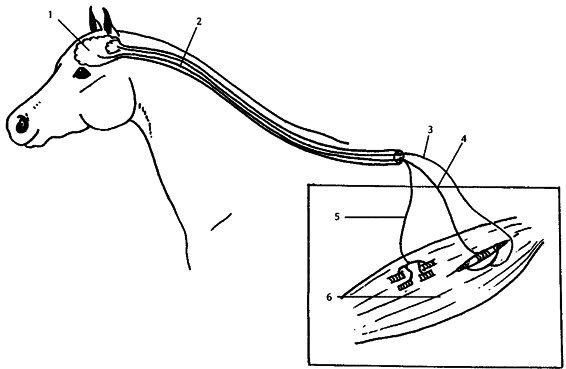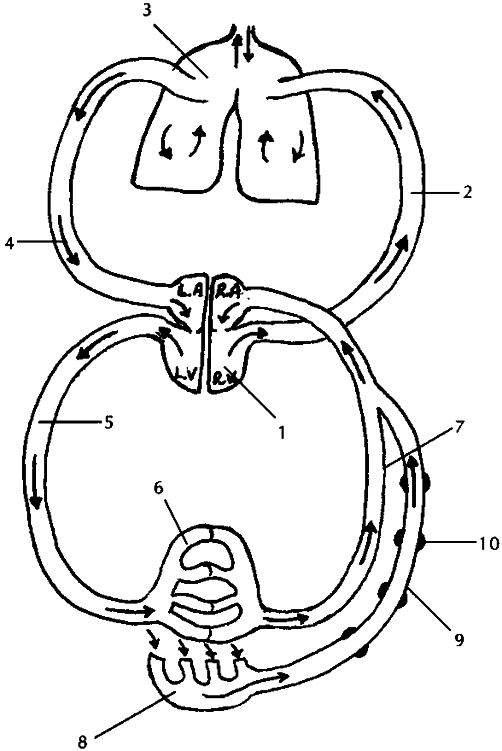Equine Massage: A Practical Guide (5 page)
Read Equine Massage: A Practical Guide Online
Authors: Jean-Pierre Hourdebaigt

Much practice is required. Learn to “see” with your hands and listen to your horse’s body “telling its own tale.”This is the most efficient way to contribute to proper maintenance and therapy. Let’s stop horsing around and get to it.
Enjoy your newfound awareness.
5
Plantar
Caudal
almarP
sal
Lateral
entral
Dor
V
Cranial
sal
Medial
Dor
s
ermT
tomical
Rostral
Horse Ana
.1
IN
1
ANATOMY AND PHYSIOLOGY
OF THE HORSE
For massage therapy to be effective, its practitioner must have a good knowledge of a horse’s makeup. In this chapter, we will exam-ine the systems of the horse and the way in which these systems work together to promote the horse’s health.To begin, we have:
❖ The nervous system (brain, spinal cord, sensory and motor nerves), which controls all the other systems.
❖ The respiratory system (trachea and lungs), which transmits oxygen to the bloodstream and removes carbon dioxide.
❖ The cardiovascular system (heart, blood, arteries, and veins), which conveys nutrients, oxygen and other essential components throughout the body.
❖ The lymphatic system (lymph channels and lymph glands), which provides a cleansing, filtering, and defense mechanism to deal with anything that could have a toxic effect on the body (lactic acid, bacteria, and viruses).
❖ The endocrine system, which is composed of glands that permit a range of functions in the body systems.
❖ The digestive system (mouth, stomach, intestines, and bowel), which extracts nutrients from food and eliminates waste.
❖ The urinary system (bladder and kidneys), which removes excess water and unwanted substances by filtering the blood through the kidneys.
❖ The reproductive system, which ensures the continuance of the species.
❖ The skeletal system, which is the bony frame that supports the body. Within the skeletal system there are joints which permit part of the bony frame to articulate (move).
❖ The muscular system, which provides the power and means to move the bony frame.
6
Anatomy and Physiology of the Horse
7
These systems are described briefly so that you can understand how each functions and relates to the other systems. More detailed information is beyond the scope of this book.
The Nervous System
The nervous system integrates and controls every body function; it processes all information and governs all commands to the body.
In the nervous system we find:
❖ The central nervous system (CNS) consists of the brain and spinal cord, which perform very specific functions. The CNS is often compared to a complex computer.
❖ The peripheral nervous system (PNS) consists of numerous pairs of nerves that exit the spinal column at the vertebral level (spinal bones). There are sensory nerves (or afferent nerves) which carry information from the body to the CNS, and there are motor nerves (or efferent nerves) which carry information from the CNS to the body parts.
❖ The specialized sensory organs.
Complex in their makeup, nerve tissues are composed of many filaments that are very susceptible to pressure. In a case of severe trauma, when significant or strong pressure is applied to a nerve, nerve impulses can stop traveling along it. As a consequence, two things can happen: a loss of sensation or feedback from the nerve area to the CNS; and degeneration with eventual shrinking of the tissue in the immediate area of the affected nerve, as a result of lost motor nerve impulses from the CNS to the body part.
A
sweeney
is a typical example of a loss of motor nerve conduction. It is caused by a direct trauma to the point of the horse’s shoulder. In this case, the suprascapular nerve that activates the muscles of the scapula is damaged.
The functioning of the nervous system is ensured by the autonomic nervous system (ANS), which maintains a stable internal environment. The ANS governs the vital organs and their complex functions that are normally carried out involuntarily, such as breathing, circulation, digestion, elimination, and the immune response.This system has two major divisions: the sympathetic and the parasympathetic. Both originate in the brain.
The
sympathetic division
causes the body to respond to danger, adversity, stress, anger, and pleasure by increasing the heart rate, blood pressure, air exchange volume, and blood flowing to muscles—
all of which are needed for the horse to spring into action. The sympathetic division is responsible for the horse’s “fight or flight”
reaction. General stimulation of the sympathetic division results in

8
Equine Massage
Anatomy and Physiology of the Horse
9
k
uttoc
k
k
k
hin
uzzle
hestnut
(27) croup
(28) doc
(29) point of hip
(30) point of b
(31) stifle
(32) c
(33) gaskin
(34) hoc
(35) m
(36) fetloc
(37) c
num
h
n
all
th
y
k
hest
ibs
(14) ergot
(15) paster
(16) coronet
(17) hoof w
(18) c
(19) r
(20) costal arc
(21) xiphoid process of ster
(22) gir
(23) bell
(24) flank
(25) bac
(26) loins
h
k
m
oints of the HorseP
idge of the nose
1.1
(1) poll
(2) foreloc
(3) br
(4) throatlatc
(5) crest
(6) shoulder
(7) withers
(8) point of shoulder
(9) elbow
(10) forear
(11) knee
(12) cannon
(13) jaw

10
Equine Massage
1.2 Nervous System
(1) brain
(4) afferent nerve, muscle spindle
(2) spinal cord
sensory nerve
(3) afferent nerve, Golgi apparatus
(5) efferent motor nerve
sensory nerve
(6) muscle
mobilization of resources to prepare the body to act or to deal with emergencies. (The warm-up routine in chapter 6 is designed to stimulate the nervous system.)The
parasympathetic division
monitors body functions during times of rest, sleep, digestion, and elimination, when the body is not ready to go into action. General stimulation of the parasympathetic division promotes relaxation and vegetative functions of the body such as breathing, circulation, digestion, immune response, and reproduction. (The relaxation routine in chapter 6 is designed to relax the nervous system.) The Respiratory System
The respiratory system includes the nose, mouth, pharynx, windpipe (or trachea), bronchial tubes, and lungs.
❖ The larynx is the organ of the voice.
❖ The lungs are somewhat elastic (expandable) and filled with numerous sacs (pulmonary alveoli) like a sponge. In the lungs, the blood takes on oxygen and gives off carbon dioxide (or waste).
❖ The diaphragm is a large, flat, muscular organ that separates the thoracic and abdominal cavities. Its action aids inhalation, expiration, and defecation.
Anatomy and Physiology of the Horse
11
Proper breathing is essential for good body metabolism. An exchange of oxygen and carbon dioxide is necessary for the body to remain vital and healthy. The horse’s respiratory system also plays an important role in regulating his body heat and in maintaining the acid-base pH balance.
Oxygen is integral to the anabolic and catabolic processes that occur naturally in all structures. The oxygen/carbon dioxide exchange rate depends on how clean the lung tissues are, the depth of respiration, the animal’s temperature (which causes expansion or dilation of blood vessels in tissues), and the rate of respiration. The rate of breathing for a horse at rest is around 12
to 16 breaths per minute; during heavy exercise, the rate is between 120 and 180. A cool-down period after strenuous exercise is essential to allow more time for the lungs to exchange gases, release toxins, and take in fresh oxygen.
Depth of respiration is very important. A girth that is too tight restricts the expansion of the rib cage.An improperly fitted saddle and a rider’s tense legs also restrict the expansion of the rib cage, consequently limiting lung capacity.
Muscular problems such as
chronic stress points
(small spasms) and
trigger points
(areas of lactic acid buildup) will restrict the muscle action required to expand and contract the rib cage. (The recuperation massage routine in chapter 6 is designed to assist this problem.) Massage will help release any undue tension and relieve stress and trigger points around the rib cage, thus allowing for deeper breathing. (The stress point check-up massage routine in chapter 10 is designed to help you recognize potential stress point locations in and around the rib cage area.)
Massage indirectly assists in the oxygenation of tissues by increasing circulation throughout the body. Massage also relaxes the nervous system, thus allowing for deeper and steadier breathing, and better oxygen/CO gas exchange.
2
The Circulatory System
The circulatory system consists of the cardiovascular system and the lymphatic system. Circulation has a number of functions:
❖ Distributing oxygen and nutrients to every cell of a horse’s body.
❖ Carrying antibodies to fight infections that invade the body.
❖ Removing metabolic waste and carbon dioxide.
❖ Distributing heat throughout the body, thereby regulating the horse’s temperature.

12
Equine Massage
1.3 Circulatory System
(1) heart
(2) pulmonary artery
(3) lungs
(4) pulmonary vein
(5) artery
(6) blood capillaries
(7) vein
(8) lymph capillaries
(9) lymphatic vessel
(10) lymph node
The Cardiovascular System
The bulk of circulatory work is done by the cardiovascular system, which is made up of the heart, arteries, veins, capillaries, and the blood that flows through them.This is a closed-circuit system.
Arterial blood carries oxygen, nutrients, immune defense agents, glandular secretions, and blood-clotting agents throughout the body. Arterial blood circulation is generated by the pumping action of the heart and the contraction of the arterial wall muscles.